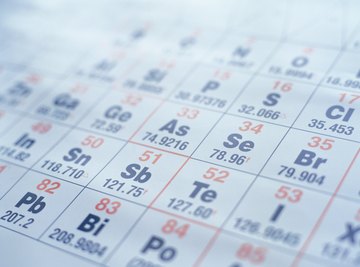
Oxidation numbers reflect the hypothetical charges of atoms in compounds. While ions have actual electric charges, molecular atoms do not necessarily have charges. However, they can attract the electrons in a molecule in unbalanced ways. Oxidation numbers reflect this tendency, and electronegativity helps determine which atoms attract the electrons in a molecule.
Oxidation Numbers
Oxidation numbers can be positive, negative or zero. An oxidation number of zero is associated with a pure element in its ground state. If the oxidation number of an atom is positive, the atom has fewer electrons than its ground state. If the oxidation number of an atom is negative, the atom has a greater number of electrons than its ground state.
Electronegativity
Electronegativity describes the tendency of an atom to attract the electrons in a chemical bond. Elements with a large electronegativity exert a greater pull on electrons than elements with small electronegativities. Ultimately, the electronegativity difference between the atoms in a compound can help determine the nature of the compound's bonds. When the electronegativity difference is between zero and 0.4, the bond between atoms is covalent. When the electronegativity difference is 1.8 or more, the bond is ionic. When the electronegativity difference is between 0.5 and 1.7, the bond is polar covalent.
Electronegativity and Oxidation Numbers
Because electronegativity dictates the distribution of electrons in a molecule, it can also help you determine oxidation numbers. For example, consider a water molecule. The oxygen atom has an electronegativity of 3.5, whereas each hydrogen atom has an electronegativity of 2.2. Therefore, this molecule is polar, and the oxygen atom attracts the electrons away from the hydrogen atoms. This imbalance is reflected in the oxidation numbers. Oxygen in a water molecule has an oxidation number of -2, whereas each hydrogen atom has an oxidation number of +1. In general, the atom with a larger electronegativity will have a negative oxidation number, and the atom with a smaller electronegativity will have a positive oxidation number.
Trends in Electronegativity
The electronegativity of elements on the periodic table generally increases as you move horizontally across the table and decreases as you move vertically down the table. The periodicity of electronegativity helps determine trends in oxidation numbers. For example, the elements closer to the right edge of the table tend to have negative oxidation numbers due to their higher electronegativities. Conversely, the elements on the left side of the table tend to have positive oxidation numbers due to their lower electronegativities.
References
About the Author
Serm Murmson is a writer, thinker, musician and many other things. He has a bachelor's degree in anthropology from the University of Chicago. His concerns include such things as categories, language, descriptions, representation, criticism and labor. He has been writing professionally since 2008.
Photo Credits
Ryan McVay/Photodisc/Getty Images
